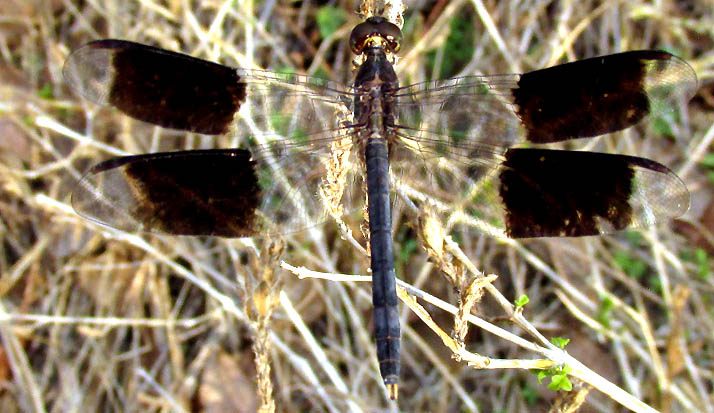Excerpts from Jim Conrad's
Naturalist Newsletter
Entry issued on May 22, 2019, from Tepakán, Yucatán, MÉXICO
BAND-WINGED DRAGONLET
In front of the little rock house I live in near Tepakán, an ordinary-looking dragonfly rested on a weed stem, shown below:

I was surprised to see this dragonfly because the Yucatan is arid, here in the interior we have no lakes or rivers, and in the Tepakán area I've yet to find a sinkhole, or cenote, with water in its bottom, or even an artificial little pond. Dragonflies normally appear around water, but there seemed to be no water here.
Identification was fairly easy, by doing a Google image search on the keywords "dragonfly Yucatan," and scanning the resulting thumbnails, looking for species with such boldly patterned wings. Since the Yucatan is so arid, we have relatively few species here, which helps with the ID process.
So this is the Band-winged Dragonlet, ERYTHRODIPLAX UMBRATA, native from Florida and Texas south through Mexico and Central America, to Argentina in South America, though in 2006 one was photographed in Cincinnati, Ohio. The species seems poised to expand northward with global warming. Its habitat is described as "permanent and temporary marshy ponds, pools and lakes," which can be said for the vast majority of the 6500 species of the Dragonfly/Damselfly order the Odonata. In fact, hardly any outstanding feature distinguishes Band-winged Dragonlets from many other species, except some obscure technical features, such in the wing venation there's a line between the M4 and Msp1 cell.
However, the fact that ours was in a place where few dragonflies ever turn up, suggests a reason for the Band-winged Dragonlet's especially large area of distribution: It's adaptable and can survive in stressful situations, such as the very dry rancho area.